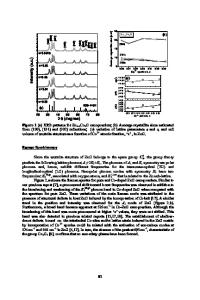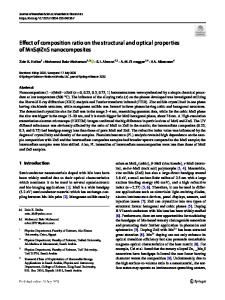Structural, optical, and magnetic properties of Mn-doped ZnS nanoparticles
- PDF / 861,294 Bytes
- 10 Pages / 595.276 x 790.866 pts Page_size
- 73 Downloads / 416 Views
Structural, optical, and magnetic properties of Mndoped ZnS nanoparticles Vishwanath D. Mote1,* 1 2
and B. N. Dole2
Thin Films and Materials Science Research Laboratory, Department of Physics, Dayanand Science College, Latur 413 512, India Advanced Materials Research Laboratory, Department of Physics, Dr. B. A. M. University, Aurangabad 431 004, India
Received: 19 August 2020
ABSTRACT
Accepted: 28 October 2020
Undoped and Mn-doped ZnS nanoparticles were successfully prepared through a coprecipitation method at low-temperature processing. The X-ray diffraction patterns reveal that the undoped and Mn-doped ZnS nanoparticles have polycrystalline nature with cubic ZnS structure. Furthermore, the lattice constant of the ZnS nanoparticles increases with an increase in the Mn doping concentration. Transmission electron microscope images demonstrated the as-synthesized nanoparticles have particle size ranging from 3 to 5 nm with spherical-shaped particles. Optical band gap values were found to increase from 3.32 to 3.50 eV with the increasing Mn doping concentration. The magnetic properties of undoped and Mn-doped ZnS samples were studied using the vibrating sample magnetometer at room temperature. The synthesized undoped ZnS nanoparticles exhibit ferromagnetism, while Mn-doped ZnS nanoparticles showed paramagnetism at room temperature. Moreover, the saturation magnetization of Mndoped ZnS samples is higher compared to undoped ZnS. The present synthesis technique to produce high-crystalline quality Mn-doped ZnS nanoparticles and prepared nanoparticles has great potential applications in spintronic and optoelectronic devices.
Ó
Springer Science+Business
Media, LLC, part of Springer Nature 2020
1 Introduction Among all the nanoscale particles, semiconductor nanoparticles have been extensively studied because of their potential applications in various technological fields, such as spintronics, light-emitting displays, field emitters, and lasers [1–6]. Besides these fields, the nanospintronic device required semiconductors that show room-temperature ferromagnetism (RTFM) and their applications, such as magnetic
Address correspondence to E-mail: [email protected]
https://doi.org/10.1007/s10854-020-04790-w
sensors, electro-optic modulators, photoconductors, light-emitting materials, field effect transistors, and magneto-optical devices [7–10]. Mandal et al. [11] predicated that the transition metal ions play an important role to improve optical, electrical, and magnetic properties of the semiconductors at room temperature [5]. Amid the II–VI semiconductor nanostructures, ZnS is one of the semiconductors having good chemical stability, wide band gap (3.68 eV) at 300 K, and high exciton binding energy
J Mater Sci: Mater Electron
(40 meV) as compared to the other materials [12–14]. Therefore, since these unique characteristics of ZnS semiconductor nanoparticles are more appropriate for the fabrication of various devices, including optoelectronic and luminescent applications, such as green light-emitting diodes
Data Loading...










